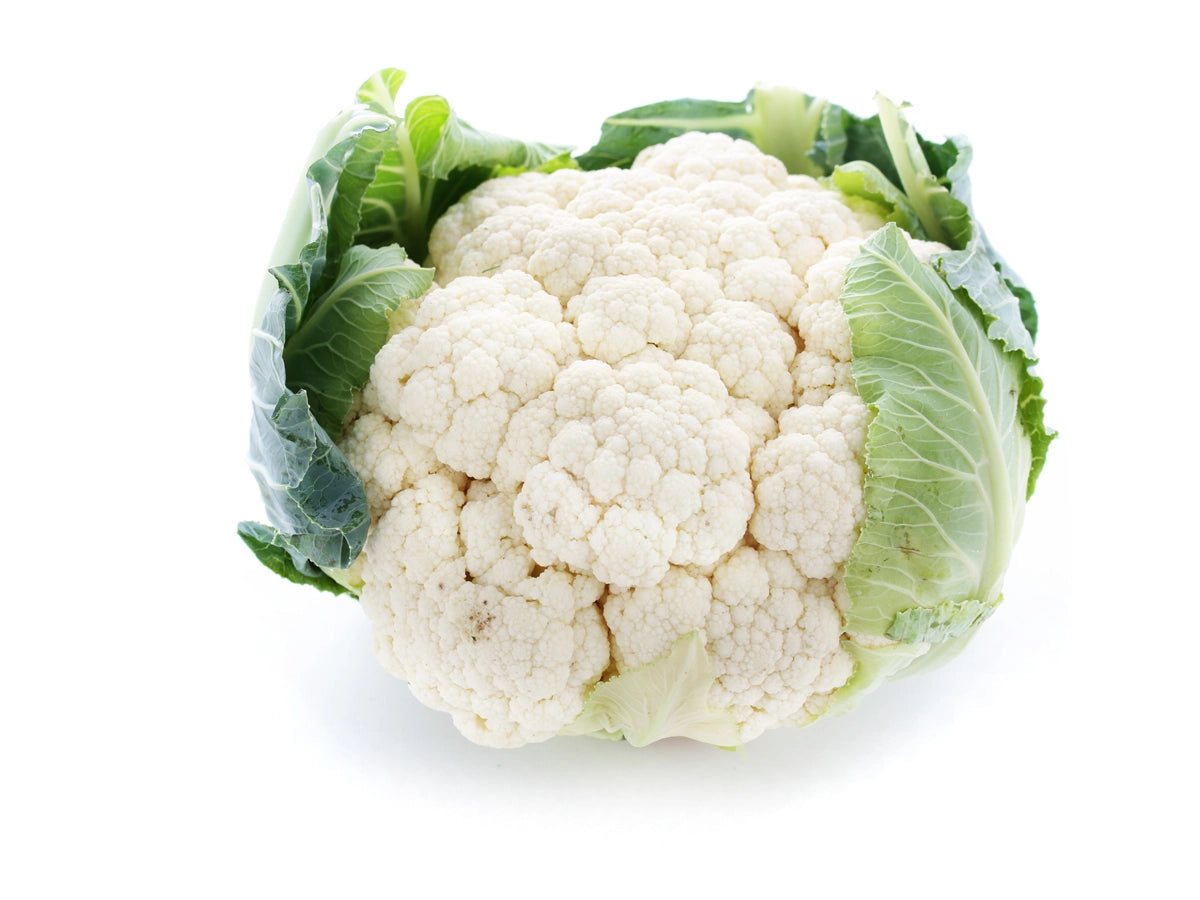How to Grow
Cauliflower: Facts, Benefits, How to Grow at Home Easily & Care Tips
What's cabbage with a college education?
Any guesses?
According to Mark Twain, the answer is "cauliflower."
Wondering what made him say that.
Perhaps the vitamin C and potassium levels in cauliflower are higher than in cabbage. That's what makes cauliflower healthier than its cousin.
A cold-weather vegetable, cauliflower is enjoyed most in the winter months. Who doesn't love a plate of hot gobhi parantha (cauliflower flatbread) in the morning?
In this blog, we will talk about growing cauliflower at home. We will cover the following: -
- Unknown facts about cauliflower
- How to grow cauliflower in your garden
- How to take care of cauliflower plants
- Major health benefits of cauliflower
So, let's enter the tasty world of cauliflower.
Unknown facts about cauliflower
- Cauliflower is one of several vegetables in the species Brassica oleracea in the genus Brassica, which is in the Brassicaceae (or mustard) family.
- Cauliflower shares a family with kale, turnips, radish, and cabbage.
- China is the largest producer of cauliflowers in the world, followed by India. In 2020, these countries produced 72% of the total world production of cauliflowers.
- People are becoming increasingly aware of and interested in a gluten-free diet due to numerous studies in the health and medical fields. Cauliflower is precisely what they were looking for! It is low-calorie and gluten-free.
- A new gluten-free rice known as "cauliflower rice" is becoming popular as a replacement for conventional white rice. Cauliflower florets are pulsed to create it, and the finished product is cooked in oil.
- Cauliflower flour is also being made, and it is even used to create a pizza base.
- The stems and leaves of cauliflower, which most people discard, are also nutritious and edible. They contain calcium, iron, fiber, vitamin C, and folate. In some parts of India, like West Bengal, these leaves and stems are consumed.
How to grow cauliflower in your garden
Cauliflower is not an easy vegetable to grow. You have to be careful and patient with it, but when your kitchen smells of various cauliflower dishes in the winter season, all your efforts will be worthwhile. This blog aims to provide you with simple techniques to grow cauliflower in your garden. Read below and learn how to grow cauliflower: -
Time to plant
The ideal time to plant a cauliflower would be different for different climate zones. This vegetable requires cool weather for about three months to mature appropriately. The daytime temperature should not be more than 15 degrees Celsius when cauliflower is developing. For India, the ideal time to sow seeds would be late autumn (October or November), when the temperature drops below 27 degrees Celsius.
Mark your spot
The chosen spot in your garden should receive at least 6 hours of full sunlight. A cool temperature is essential, but bright and direct sunlight is equally important. There shouldn’t be any big trees, tall grass, or other crops around this location. The cauliflower plants have to be spaced 18-24 inches apart.
Prepare your soil bed
The ideal soil for cauliflower plants should be fertile and water-retentive. Cauliflower plants require a constant supply of nutrients and moisture from the ground. That’s why you must apply high levels of organic matter to your garden soil to enhance the soil’s water-retentive ability. Also, use a potassium and nitrogen-rich fertilizer in the ground for your cauliflowers to be significant in size. After you have worked to make the soil nutrient-rich and more moisture-retentive, you have to check the soil pH. The optimal soil pH should be between 6.5 and 7.0. So, add lime or sulfur to reduce or increase soil acidity, respectively.
Prepare seeds
Cauliflower is a fragile plant, so it is suggested to start with seedlings inside, and later, you can transplant it outside. Get biodegradable pots or cups, fill them with regular potting soil, and then place the seeds. Press the seeds about 1/4th to ½ inch deep into the soil. Please keep them in a warm environment and water them regularly.
Transplant seedlings
Before transplanting the seedlings in your garden, bring them outside for one hour a day and gradually increase the time over a week. This will save the seedlings from the shock of the outside temperature. They will adapt quickly if you follow this process. You can bury the seedlings in biodegradable pots or cups in the garden soil.
Consistent watering
As stated earlier, cauliflower plants require a constant water supply and nutrients for proper growth. The cauliflowers won't be tasty if these two conditions are not met. So, never miss out on watering the plant. These plants would require one to five inches of water every week. Make sure the water successfully reaches 6 inches into the soil. Also, remember not to overwater. The ground should remain moist, not soggy. If it frequently rains where you live, you might only need to water occasionally.
Mulching
Once the seedlings are established in your garden, add a thin layer of mulch to the soil to help conserve moisture and control temperature.
Check for pests
Young, delicate cauliflower seedlings are susceptible to several garden pests, such as cabbage worms, aphids, harlequin bugs, and others. Look out for them and use a plant-friendly pesticide to get rid of them and protect your crop.
Fertilize if required
If you see sluggish growth, test your soil and supply it with the missing nutrients, like nitrogen or potassium. Every two to three weeks, apply a fertilizer rich in the lacking nutrient(s).
Blanch
The little head that develops at the center of the cauliflower leaves is called curd. Now, if this head remains exposed to light while growing, it will turn darker and not look pretty enough. Also, the texture will be harder. To keep the head white, a process is followed called blanching. For that, you have to bend the plant's leaves over the "head" when they are about the size of an egg to protect it from sunlight. If necessary, secure the leaves with rubber bands or twine. Also, don't be so firm that air cannot reach the head.
Harvest
After blanching, cauliflowers will take a few days to a few weeks to be ready for harvest. Look after the plant as usual, sometimes plucking the leaves around the plant's head to track its development and letting the water evaporate after watering. The cauliflowers will be ready for harvest when they are about 6 inches across, white, and sturdy.
This whole process from sowing to maturity takes between three and five months, but this time may vary depending on microclimatic conditions and the variety of cauliflower.
How to take care of cauliflower plants
You have to be quite cautious while taking care of cauliflower plants because they require all your attention. So, you cannot afford to miss anything written below: -
Soil
Cauliflower requires an organically rich soil with a pH range of 6.5 to 7.0. Although cauliflower needs constant hydration, the soil should also drain effectively. Deep loamy soils would be ideal for the growth of cauliflowers.
Temperature
For optimal growth of cauliflowers, the temperature should not exceed 26 degrees Celsius. The ideal temperature is 15 degrees Celsius.
Location
Choose a location in your garden that is spacious and devoid of any big trees, tall grasses, or other structures that may shade the plants. Also, the place should be sunny.
Sunlight
Cauliflower likes bright, full sunlight for at least 8-9 hours. In case the heat is too scorching, provide some shade.
Fertilizer
Generally, if you have prepared your soil well, cauliflowers won’t require any fertilizer. But if you notice that the rate of growth is slow, you can perform a soil test and learn about the missing nutrients. Then add a fertilizer that is rich in those missing nutrients. You can also apply organic fertilizer once in a while, like compost or fish water.
Water
Cauliflower requires a lot of constant moisture. The heads get bitter if there is not enough water. Make sure the water soaks 6 to 8 inches into the soil and gives plants at least 1 to 2 inches of water per week.
Major health benefits of cauliflower
It’s a treat when healthy vegetables are really tasty – isn’t it? Cauliflower is one such rare vegetable that is loaded with important nutrients. Take a look at the chart of nutritional value of one serving or 100gms of cauliflower: -
|
Calorie |
25 |
|
Calcium |
2 % of daily recommended value |
|
Carbohydrate |
5g |
|
Fat |
0.3g |
|
Iron |
2 % of daily recommended value |
|
Magnesium |
3 % of daily recommended value |
|
Potassium |
299mg |
|
Protein |
1.9g |
|
Sodium |
30mg |
|
Vitamin B6 |
10 % of daily recommended value |
|
Vitamin C |
100 % of daily recommended value |
Based on the nutrients present in cauliflowers, here is a list of probable health benefits: -
Improve immunity
Sulfur-rich cruciferous vegetables like cauliflower may promote intestinal health and strengthen your resistance to infection. This is because sulfur helps to produce glutathione, which is essential for preserving the stability of the gut lining and promoting its regeneration. Glutathione acts as a powerful antioxidant throughout the body to protect cells from inflammatory damage. Also, remember that cauliflower has a good amount of Vitamin C, which helps boost immunity.
Protects the heart
Regular cauliflower eating promotes healthy blood flow throughout the body and maintains the blood vessels in optimum shape. It's because cauliflower contains glucoraphanin and vitamin K. As glucoraphanin transforms isothiocyanates, anti-inflammatory properties are triggered, and blood vessels are prevented from accumulating lipids. This encourages continuous blood flow through the blood vessels, thereby lowering the risk of conditions like atherosclerosis and cardiovascular disorders. Therefore, eating cauliflower helps to improve cardiovascular health.
Good for bone health
Vitamin C, found in cauliflower, is essential for synthesizing collagen. The inflammatory damage to the bones and joints is stopped by collagen. In addition to vitamin C, cauliflower also contains vitamin K, which is responsible for good bone metabolism. Vitamin K helps heal wounds and injuries faster.
May prevent cancer
Cauliflower, like all other cruciferous vegetables, is anti-carcinogenic. The beneficial chemicals isothiocyanates, also known as indole-3 carbinol, sulforaphane, and glucosinolate, are present in cauliflower. According to numerous studies, the anti-estrogen and chemopreventive properties of the chemicals found in cauliflower serve to slow the growth of cancer cells.
Promotes better digestion
Cauliflowers contain dietary fiber that helps improve digestive health by easily flushing out toxins from the body. The presence of sulphraphane, glucoraphanin, glucosinolate, and isothiocyanates helps in preventing stomach-related disorders and even stomach ulcers and colon cancer.
Aids in weight loss
For those looking for a weight-loss-friendly diet, cauliflower is a must. That’s because more than 90% of cauliflower is water. There is zero fat in cauliflower, and the presence of dietary fibers helps one remain full for longer.
Promotes eye health
You will find antioxidants and vitamin C in cauliflower abundantly. Therefore, cauliflowers are excellent for lowering the risk of age-related macular degeneration, or AMD, which leads to blindness among the elderly. Cauliflower also has sulforaphane, a substance that protects retinal tissues from oxidative stress-related damage. This vegetable may also help prevent vision impairment and cataracts.
Cauliflower is a beloved vegetable, and now it is becoming more popular as a gluten-free substitute for healthier living. Take care of a cauliflower plant today; tomorrow, it will take care of you. We hope this blog inspires you to bring cauliflower into your garden space.
FAQs related to cauliflower
Is cauliflower a winter vegetable?
Cauliflower is a vegetable that grows in the winter. To mature properly, it needs a chilly climate. The best and largest varieties of cauliflower are therefore available in the vegetable market during the winter.
Does cauliflower have any health benefits, or is it eaten only for taste?
Although cauliflower is prized for its flavor, it is also endowed with vital elements that are good for the body. It contains hardly any fat, 5% of the recommended daily quantity of carbohydrates, and nearly all of vitamin C. Additionally, it is an excellent source of fiber.
Which form of cauliflower is healthier – raw or cooked?
Raw cauliflower offers more proteins and antioxidants. But as raw cauliflower cannot be eaten, you can steam it to make the stems and florets tender. Cauliflower loses its beneficial antioxidants when it is boiled.
Can cauliflower be eaten while on a weight-loss diet?
Yes, cauliflower is a healthy vegetable that can be included in your weight loss diet. It is rich in antioxidants and vitamin C and has a negligible amount of fat. Moreover, the dietary fibers and high water content will keep you full for a longer time.
Is cauliflower good for constipated people?
Yes, cauliflower can be safely consumed by people who suffer from constipation. This vegetable is rich in insoluble fiber and thus can prevent constipation and promote a healthy digestive tract.
How many types of cauliflower are there, and which one is the healthiest?
Cauliflower comes in four colors – white, green, orange, and purple. White cauliflower is the most familiar and rich source of fiber, vitamin C, and antioxidants. Green cauliflower or broccoli has more fiber than a white one. Orange cauliflower has more beta-carotene and 25 times more vitamin A than the rest. But the healthiest one is the purple cauliflower, for the presence of antioxidant anthocyanin that keeps the heart healthy and prevents inflammatory diseases.



